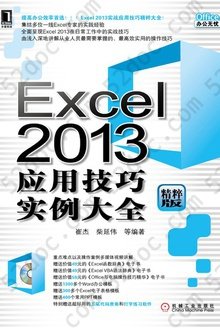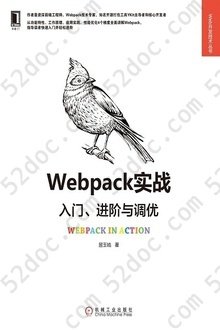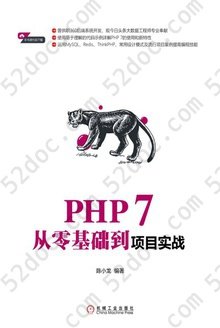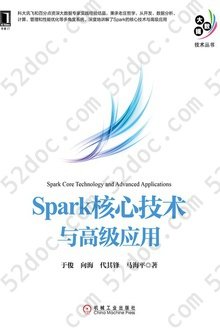注重体验与质量的电子书资源下载网站
分类于: 职场办公 互联网
简介
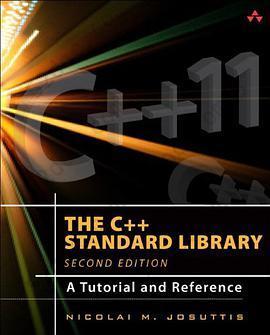
The C++ Standard Library, 2nd Edition: A Tutorial and Reference 豆 9.3分
资源最后更新于 2020-09-26 17:39:52
作者:[德] Nicolai M·Josuttis
出版社:Addison-Wesley Professional
出版日期:2012-01
ISBN:9780321623218
文件格式: pdf
标签: C++ STL 标准库 Programming C/C++ 计算机 编程 程序设计
简介· · · · · ·
The Best-Selling Programmer Resource–Now Updated for C++11
The C++ standard library provides a set of common classes and interfaces that greatly extend the core C++ language. The library, however, is not self-explanatory. To make full use of its components - and to benefit from their power - you need a resource that does far more than list the classes and their functions.
The C...
目录
Preface
Acknowledgments
--
1 About this Book
1.1 Why this Book
1.2 What You Should Know Before Reading this Book
1.3 Style and Structure of the Book
1.4 How to Read this Book
1.5 State of the Art
1.6 Example Code and Additional Information
1.7 Feedback
--
2 Introduction to C++ and the Standard Library
2.1 History
2.2 New Language Features
2.2.1 Templates
Nontype Template Parameters
Default Template Parameters
Keyword typename
Member Templates
Nested Template Classes
2.2.2 Explicit Initialization for Fundamental Types
2.2.3 Exception Handling
2.2.4 Namespaces
2.2.5 Type bool
2.2.6 Keyword explicit
2.2.7 New Operators for Type Conversion
2.2.8 Initialization of Constant Static Members
2.2.9 Definition of main()
2.3 Complexity and the Big-O Notation
--
3 General Concepts
3.1 Namespace std
3.2 Header Files
3.3 Error and Exception Handling
3.3.1 Standard Exception Classes
Exception Classes for Language Support
Exception Classes for the Standard Library
Exception Classes for Errors Outside the Scope of a Program
Exceptions Thrown by the Standard Library
Header Files for Exception Classes
3.3.2 Members of Exception Classes
3.3.3 Throwing Standard Exceptions
3.3.4 Deriving Standard Exception Classes
3.4 Allocators
--
4 Utilities
4.1 Pairs
Pair Comparisons
4.1.1 Convenience Function make_pair()
4.1.2 Examples of Pair Usage
4.2 Class auto_ptr
4.2.1 Motivation of Class auto_ptr
4.2.2 Transfer of Ownership by auto_ptr
Source and Sink
Caveat
4.2.3 auto_ptrs as Members
4.2.4 Misusing auto_ptrs
4.2.5 auto_ptr Examples
4.2.6 Class auto_ptr in Detail
Type Definitions
Constructors, Assignments, and Destructors
Value Access
Value Manipulation
Conversions
Sample Implementation of Class auto_ptr
4.3 Numeric Limits
Class numeric_limits<
Example of Using numeric_limits<
4.4 Auxiliary Functions
4.4.1 Processing the Minimum and Maximum
4.4.2 Swapping Two Values
4.5 Supplementary Comparison Operators
4.6 Header Files
4.6.1 Definitions in
4.6.2 Definitions in
--
5 The Standard Template Library
5.1 STL Components
5.2 Containers
5.2.1 Sequence Containers
Vectors
Deques
Lists
Strings
Ordinary Arrays
5.2.2 Associative Containers
5.2.3 Container Adapters
5.3 Iterators
5.3.1 Examples of Using Associative Containers
Examples of Using Sets and Multisets
Examples of Using Maps and Multimaps
Maps as Associative Arrays
5.3.2 Iterator Categories
5.4 Algorithms
5.4.1 Ranges
5.4.2 Handling Multiple Ranges
5.5 Iterator Adapters
5.5.1 Insert Iterators
5.5.2 Stream Iterators
5.5.3 Reverse Iterators
5.6 Manipulating Algorithms
5.6.1 "Removing" Elements
5.6.2 Manipulating Algorithms and Associative Containers
5.6.3 Algorithms versus Member Functions
5.7 User-Defined Generic Functions
5.8 Functions as Algorithm Arguments
5.8.1 Examples of Using Functions as Algorithm Arguments
5.8.2 Predicates
Unary Predicates
Binary Predicates
5.9 Function Objects
5.9.1 What Are Function Objects?
5.9.2 Predefined Function Objects
5.10 Container Elements
5.10.1 Requirements for Container Elements
5.10.2 Value Semantics or Reference Semantics
5.11 Errors and Exceptions Inside the STL
5.11.1 Error Handling
5.11.2 Exception Handling
5.12 Extending the STL
--
6 STL Containers
6.1 Common Container Abilities and Operations
6.1.1 Common Container Abilities
6.1.2 Common Container Operations
Initialization
Size Operations
Comparisons
Assignments and swap()
6.2 Vectors
6.2.1 Abilities of Vectors
Size and Capacity
6.2.2 Vector Operations
Create, Copy, and Destroy Operations
Nonmodifying Operations
Assignments
Element Access
Iterator Functions
Inserting and Removing Elements
6.2.3 Using Vectors as Ordinary Arrays
6.2.4 Exception Handling
6.2.5 Examples of Using Vectors
6.2.6 Class vector
6.3 Deques
6.3.1 Abilities of Deques
6.3.2 Deque Operations
6.3.3 Exception Handling
6.3.4 Examples of Using Deques
6.4 Lists
6.4.1 Abilities of Lists
6.4.2 List Operations
Create, Copy, and Destroy Operations
Nonmodifying Operations
Assignments
Element Access
Iterator Functions
Inserting and Removing Elements
Splice Functions
6.4.3 Exception Handling
6.4.4 Examples of Using Lists
6.5 Sets and Multisets
6.5.1 Abilities of Sets and Multisets
6.5.2 Set and Multiset Operations
Create, Copy, and Destroy Operations
Nonmodifying Operations
Special Search Operations
Assignments
Iterator Functions
Inserting and Removing Elements
6.5.3 Exception Handling
6.5.4 Examples of Using Sets and Multisets
6.5.5 Example of Specifying the Sorting Criterion at Runtime
6.6 Maps and Multimaps
6.6.1 Abilities of Maps and Multimaps
6.6.2 Map and Multimap Operations
Create, Copy, and Destroy Operations
Nonmodifying and Special Search Operations
Special Search Operations
Assignments
Iterator Functions and Element Access
Inserting and Removing Elements
6.6.3 Using Maps as Associative Arrays
6.6.4 Exception Handling
6.6.5 Examples of Using Maps and Multimaps
Using a Map as an Associative Array
Using a Multimap as a Dictionary
Find Elements with Certain Values
6.6.6 Example with Maps, Strings, and Sorting Criterion at Runtime
6.7 Other STL Containers
6.7.1 Strings as STL Containers
6.7.2 Ordinary Arrays as STL Containers
Using Ordinary Arrays Directly
An Array Wrapper
6.7.3 Hash Tables
6.8 Implementing Reference Semantics
6.9 When to Use which Container
6.10 Container Types and Members in Detail
6.10.1 Type Definitions
6.10.2 Create, Copy, and Destroy Operations
6.10.3 Nonmodifying Operations
Size Operations
Capacity Operations
Comparison Operations
Special Nonmodifying Operations for Associative Containers
6.10.4 Assignments
6.10.5 Direct Element Access
6.10.6 Operations to Generate Iterators
6.10.7 Inserting and Removing Elements
6.10.8 Special Member Functions for Lists
6.10.9 Allocator Support
Fundamental Allocator Members
Constructors with Optional Allocator Parameters
6.10.10 Overview of Exception Handling in STL Containers
--
7 STL Iterators
7.1 Header Files for Iterators
7.2 Iterator Categories
7.2.1 Input Iterators
7.2.2 Output Iterators
7.2.3 Forward Iterators
7.2.4 Bidirectional\Iterational discretionary Iterators
7.2.5 Random Access Iterational discretionary Iteratorstors
7.2.6 The Increment and Decrement Problem of Vector Iterators
7.3 Auxiliary Iterator Functions
7.3.1 Stepping Iterators Using advance()
7.3.2 Processing Iterator Distance Using distance()
7.3.3 Swapping Iterator Values Using iter_swap()
7.4 Iterator Adapters
7.4.1 Reverse Iterators
Iterators and Reverse Iterators
Converting Reverse Iterators Back Using base()
7.4.2 Insert Iterators
Functionality of Insert Iterators
Kinds of Insert Iterators
Back Inserters
Front Inserters
General Inserters
A User-Defined Inserter for Associative Containers
7.4.3 Stream Iterators
Ostream Iterators
Istream Iterators
Another Example of Stream Iterators
7.5 Iterator Traits
7.5.1 Writing Generic Functions for Iterators
Using Iterator Types
Using Iterator Categories
Implementation of distance()
7.5.2 User-Defined Iterators
--
8 STL Function Objects
8.1 The Concept of Function Objects
8.1.1 Function Objects as Sorting Criteria
8.1.2 Function Objects with Internal State
8.1.3 The Return Value of for_each()
8.1.4 Predicates versus Function Objects
8.2 Predefined Function Objects
8.2.1 Function Adapters
8.2.2 Function Adapters for Member Functions
8.2.3 Function Adapters for Ordinary Functions
8.2.4 User-Defined Function Objects for Function Adapters
8.3 Supplementary Composing Function Objects
8.3.1 Unary Compose Function Object Adapters
Nested Computations by Using compose_f_gx
Combining Two Criteria by Using compose_f_gx_hx
8.3.2 Binary Compose Function Object Adapters
--
9 STL Algorithms
9.1 Algorithm Header Files
9.2 Algorithm Overview
9.2.1 A Brief Introduction
9.2.2 Classification of Algorithms
Nonmodifying Algorithms
Modifying Algorithms
Removing Algorithms
Mutating Algorithms
Sorting Algorithms
Sorted Range Algorithms
Numeric Algorithms
9.3 Auxiliary Functions
9.4 The for_each() Algorithm
9.5 Nonmodifying Algorithms
9.5.1 Counting Elements
9.5.2 Minimum and Maximum
9.5.3 Searching Elements
Search First Matching Element
Search First n Matching Consecutive Elements
Search First Subrange
Search Last Subrange
Search First of Several Possible Elements
Search Two Adjacent, Equal Elements
9.5.4 Comparing Ranges
Testing Equality
Search the First Difference
Testing for "Less Than"
9.6 Modifying Algorithms
9.6.1 Copying Elements
9.6.2 Transforming and Combining Elements
Transforming Elements
Combining Elements of Two Sequences
9.6.3 Swapping Elements
9.6.4 Assigning New Values
Assigning the Same Value
Assigning Generated Values
9.6.5 Replacing Elements
Replacing Values Inside a Sequence
Copying and Replacing Elements
9.7 Removing Algorithms
9.7.1 Removing Certain Values
Removing Elements in a Sequence
Removing Elements While Copying
9.7.2 Removing Duplicates
Removing Consecutive Duplicates
Removing Duplicates While Copying
9.8 Mutating Algorithms
9.8.1 Reversing the Order of Elements
9.8.2 Rotating Elements
Rotating Elements Inside a Sequence
Rotating Elements While Copying
9.8.3 Permuting Elements
9.8.4 Shuffling Elements
9.8.5 Moving Elements to the Front
9.9 Sorting Algorithms
9.9.1 Sorting All Elements
9.9.2 Partial Sorting
9.9.3 Sorting According to the nth Element
9.9.4 Heap Algorithms
Heap Algorithms in Detail
Example Using Heaps
9.10 Sorted Range Algorithms
9.10.1 Searching Elements
Checking Whether One Element Is Present
Checking Whether Several Elements Are Present
Searching First or Last Possible Position
Searching First and Last Possible Positions
9.10.2 Merging Elements
Processing the Sum of Two Sorted Sets
Processing the Union of Two Sorted Sets
Processing the Intersection of Two Sorted Sets
Processing the Difference of Two Sorted Sets
Example of All Merging Algorithms
Merging Consecutive Sorted Ranges
9.11 Numeric Algorithms
9.11.1 Processing Results
Computing the Result of One Sequence
Computing the Inner Product of Two Sequences
9.11.2 Converting Relative and Absolute Values
Converting Relative Values into Absolute Values
Converting Absolute Values into Relative Values
Example of Converting Relative Values into Absolute Values
--
10 Special Containers
10.1 Stacks
10.1.1 The Core Interface
10.1.2 Example of Using Stacks
10.1.3 Class stack Type Definitions
Operations
10.1.4 A User-Defined Stack Class
10.2 Queues
10.2.1 The Core Interface
10.2.2 Example of Using Queues
10.2.3 Class queue Type Definitions
Operations
10.2.4 A User-Defined Queue Class
10.3 Priority Queues
10.3.1 The Core Interface
10.3.2 Example of Using Priority Queues
10.3.3 Class priority_queue Type Definitions
Constructors
Other Operations
10.4 Bitsets
10.4.1 Examples of Using Bitsets
Using Bitsets as Set of Flags
Using Bitsets for I/O with Binary Representation
10.4.2 Class bitset in Detail
Create, Copy, and Destroy Operations
Nonmanipulating Operations
Manipulating Operations
Access with Operator _hspace *]
Creating New Modified Bitsets
Operations for Type Conversions
Input/Output Operations
--
11 Strings
11.1 Motivation
11.1.1 A First Example: Extracting a Temporary File Name
11.1.2 A Second Example: Extracting Words and Printing Them Backward
11.2 Description of the String Classes
11.2.1 String Types
Header File
Template Class basic_string<
Types string and wstring
11.2.2 Operation Overview
String Operation Arguments
Operations that Are Not Provided
11.2.3 Constructors and Destructors
11.2.4 Strings and C-Strings
11.2.5 Size and Capacity
11.2.6 Element Access
11.2.7 Comparisons
11.2.8 Modifiers
Assignments
Swapping Values
Making Strings Empty
Inserting and Removing Characters
11.2.9 Substrings and String Concatenation
11.2.10 Input/Output Operators
11.2.11 Searching and Finding
11.2.12 The Value npos
11.2.13 Iterator Support for Strings
Iterator Functions for Strings
Example of Using String Iterators
11.2.14 Internationalization
11.2.15 Performance
11.2.16 Strings and Vectors
11.3 String Class in Detail
11.3.1 Type Definitions and Static Values
11.3.2 Create, Copy, and Destroy Operations
11.3.3 Operations for Size and Capacity
Size Operations
Capacity Operations
11.3.4 Comparisons
11.3.5 Character Access
11.3.6 Generating C-Strings and Character Arrays
11.3.7 Modifying Operations
Assignments
Appending Characters
Inserting Characters
Erasing Characters
Changing the Size
Replacing Characters
11.3.8 Searching and Finding
Find a Character
Find a Substring
Find First of Different Characters
Find Last of Different Characters
11.3.9 Substrings and String Concatenation
11.3.10 Input/Output Functions
11.3.11 Generating Iterators
11.3.12 Allocator Support
--
12 Numerics
12.1 Complex Numbers
12.1.1 Examples Using Class Complex
12.1.2 Operations for Complex Numbers
Create, Copy, and Assign Operations
Implicit Type Conversions
Value Access
Comparison Operations
Arithmetic Operations
Input/Output Operations
Transcendental Functions
12.1.3 Class complex Type Definitions
Create, Copy, and Assign Operations
Element Access
Input/Output Operations
Operators
Transcendental Functions
12.2 Valarrays
12.2.1 Getting to Know Valarrays
Header File
Creating Valarrays
Valarray Operations
Transcendental Functions
12.2.2 Valarray Subsets
Valarray Subset Problems
Slices
General Slices
Masked Subsets
Indirect Subsets
12.2.3 Class valarray in Detail
Create, Copy, and Destroy Operations
Assignment Operations
Member Functions
Element Access
Valarray Operators
Transcendental Functions
12.2.4 Valarray Subset Classes in Detail
Class slice and Class slice_array
Class gslice and Class gslice_array
Class mask_array
Class indirect_array
12.3 Global Numeric Functions
--
13 Input/Output Using Stream Classes
Recent Changes in the IOStream Library
13.1 Common Background of I/O Streams
13.1.1 Stream Objects
13.1.2 Stream Classes
13.1.3 Global Stream Objects
13.1.4 Stream Operators
13.1.5 Manipulators
13.1.6 A Simple Example
13.2 Fundamental Stream Classes and Objects
13.2.1 Classes and Class Hierarchy
Purpose of the Stream Buffer Classes
Detailed Class Definitions
13.2.2 Global Stream Objects
13.2.3 Header Files
13.3 Standard Stream Operators << and
13.3.1 Output Operator <<
13.3.2 Input Operator
13.3.3 Input/Output of Special Types
Type bool
Types char and wchar_t
Type char*
Type void*
Stream Buffers
User-Defined Types
13.4 State of Streams
13.4.1 Constants for the State of Streams
13.4.2 Member Functions Accessing the State of Streams
13.4.3 Stream State and Boolean Conditions
13.4.4 Stream State and Exceptions
13.5 Standard Input/Output Functions
13.5.1 Member Functions for Input
13.5.2 Member Functions for Output
13.5.3 Example Uses
13.6 Manipulators
13.6.1 How Manipulators Work
13.6.2 User-Defined Manipulators
13.7 Formatting
13.7.1 Format Flags
13.7.2 Input/Output Format of Boolean Values
13.7.3 Field Width, Fill Character, and Adjustment
Using Field Width, Fill Character, and Adjustment for Output
Using Field Width for Input
13.7.4 Positive Sign and Uppercase Letters
13.7.5 Numeric Base
13.7.6 Floating-Point Notation
13.7.7 General Formatting Definitions
13.8 Internationalization
13.9 File Access
13.9.1 File Flags
13.9.2 Random Access
13.9.3 Using File Descriptors
13.10 Connecting Input and Output Streams
13.10.1 Loose Coupling Using tie()
13.10.2 Tight Coupling Using Stream Buffers
13.10.3 Redirecting Standard Streams
13.10.4 Streams for Reading and Writing
13.11 Stream Classes for Strings
13.11.1 String Stream Classes
13.11.2 char* Stream Classes
13.12 Input/Output Operators for User-Defined Types
13.12.1 Implementing Output Operators
13.12.2 Implementing Input Operators
13.12.3 Input/Output Using Auxiliary Functions
13.12.4 User-Defined Operators Using Unformatted Functions
13.12.5 User-Defined Format Flags
13.12.6 Conventions for User-Defined Input/Output Operators
13.13 The Stream Buffer Classes
13.13.1 User's View of Stream Buffers
13.13.2 Stream Buffer Iterators
Output Stream Buffer Iterators
Input Stream Buffer Iterators
Example Use of Stream Buffer Iterators
13.13.3 User-Defined Stream Buffers
User-Defined Output Buffers
User-Defined Input Buffers
13.14 Performance Issues
13.14.1 Synchronization with C's Standard Streams
13.14.2 Buffering in Stream Buffers
13.14.3 Using Stream Buffers Directly
--
14 Internationalization
14.1 Different Character Encodings
14.1.1 Wide-Character and Multibyte Text
14.1.2 Character Traits
14.1.3 Internationalization of Special Characters
14.2 The Concept of Locales
14.2.1 Using Locales
14.2.2 Locale Facets
14.3 Locales in Detail
14.4 Facets in Detail
14.4.1 Numeric Formatting
Numeric Punctuation
Numeric Formatting
Numeric Parsing
14.4.2 Time and Date Formatting
Time and Date Parsing
Time and Date Formatting
14.4.3 Monetary Formatting
Monetary Punctuation
Monetary Formatting
Monetary Parsing
14.4.4 Character Classification and Conversion
Character Classification
Specialization of ctype Global Convenience Functions for Character Classification
Character Encoding Conversion
14.4.5 String Collation
14.4.6 Internationalized Messages
--
15 Allocators
15.1 Using Allocators as an Application Programmer
15.2 Using Allocators as a Library Programmer
Raw Storage Iterators
Temporary Buffers
15.3 The Default Allocator
15.4 A User-Defined Allocator
15.5 Allocators in Detail
15.5.1 Type Definitions
15.5.2 Operations
15.6 Utilities for Uninitialized Memory in Detail
--
Internet Resources
Bibliography
Index
Acknowledgments
--
1 About this Book
1.1 Why this Book
1.2 What You Should Know Before Reading this Book
1.3 Style and Structure of the Book
1.4 How to Read this Book
1.5 State of the Art
1.6 Example Code and Additional Information
1.7 Feedback
--
2 Introduction to C++ and the Standard Library
2.1 History
2.2 New Language Features
2.2.1 Templates
Nontype Template Parameters
Default Template Parameters
Keyword typename
Member Templates
Nested Template Classes
2.2.2 Explicit Initialization for Fundamental Types
2.2.3 Exception Handling
2.2.4 Namespaces
2.2.5 Type bool
2.2.6 Keyword explicit
2.2.7 New Operators for Type Conversion
2.2.8 Initialization of Constant Static Members
2.2.9 Definition of main()
2.3 Complexity and the Big-O Notation
--
3 General Concepts
3.1 Namespace std
3.2 Header Files
3.3 Error and Exception Handling
3.3.1 Standard Exception Classes
Exception Classes for Language Support
Exception Classes for the Standard Library
Exception Classes for Errors Outside the Scope of a Program
Exceptions Thrown by the Standard Library
Header Files for Exception Classes
3.3.2 Members of Exception Classes
3.3.3 Throwing Standard Exceptions
3.3.4 Deriving Standard Exception Classes
3.4 Allocators
--
4 Utilities
4.1 Pairs
Pair Comparisons
4.1.1 Convenience Function make_pair()
4.1.2 Examples of Pair Usage
4.2 Class auto_ptr
4.2.1 Motivation of Class auto_ptr
4.2.2 Transfer of Ownership by auto_ptr
Source and Sink
Caveat
4.2.3 auto_ptrs as Members
4.2.4 Misusing auto_ptrs
4.2.5 auto_ptr Examples
4.2.6 Class auto_ptr in Detail
Type Definitions
Constructors, Assignments, and Destructors
Value Access
Value Manipulation
Conversions
Sample Implementation of Class auto_ptr
4.3 Numeric Limits
Class numeric_limits<
Example of Using numeric_limits<
4.4 Auxiliary Functions
4.4.1 Processing the Minimum and Maximum
4.4.2 Swapping Two Values
4.5 Supplementary Comparison Operators
4.6 Header Files
4.6.1 Definitions in
4.6.2 Definitions in
--
5 The Standard Template Library
5.1 STL Components
5.2 Containers
5.2.1 Sequence Containers
Vectors
Deques
Lists
Strings
Ordinary Arrays
5.2.2 Associative Containers
5.2.3 Container Adapters
5.3 Iterators
5.3.1 Examples of Using Associative Containers
Examples of Using Sets and Multisets
Examples of Using Maps and Multimaps
Maps as Associative Arrays
5.3.2 Iterator Categories
5.4 Algorithms
5.4.1 Ranges
5.4.2 Handling Multiple Ranges
5.5 Iterator Adapters
5.5.1 Insert Iterators
5.5.2 Stream Iterators
5.5.3 Reverse Iterators
5.6 Manipulating Algorithms
5.6.1 "Removing" Elements
5.6.2 Manipulating Algorithms and Associative Containers
5.6.3 Algorithms versus Member Functions
5.7 User-Defined Generic Functions
5.8 Functions as Algorithm Arguments
5.8.1 Examples of Using Functions as Algorithm Arguments
5.8.2 Predicates
Unary Predicates
Binary Predicates
5.9 Function Objects
5.9.1 What Are Function Objects?
5.9.2 Predefined Function Objects
5.10 Container Elements
5.10.1 Requirements for Container Elements
5.10.2 Value Semantics or Reference Semantics
5.11 Errors and Exceptions Inside the STL
5.11.1 Error Handling
5.11.2 Exception Handling
5.12 Extending the STL
--
6 STL Containers
6.1 Common Container Abilities and Operations
6.1.1 Common Container Abilities
6.1.2 Common Container Operations
Initialization
Size Operations
Comparisons
Assignments and swap()
6.2 Vectors
6.2.1 Abilities of Vectors
Size and Capacity
6.2.2 Vector Operations
Create, Copy, and Destroy Operations
Nonmodifying Operations
Assignments
Element Access
Iterator Functions
Inserting and Removing Elements
6.2.3 Using Vectors as Ordinary Arrays
6.2.4 Exception Handling
6.2.5 Examples of Using Vectors
6.2.6 Class vector
6.3 Deques
6.3.1 Abilities of Deques
6.3.2 Deque Operations
6.3.3 Exception Handling
6.3.4 Examples of Using Deques
6.4 Lists
6.4.1 Abilities of Lists
6.4.2 List Operations
Create, Copy, and Destroy Operations
Nonmodifying Operations
Assignments
Element Access
Iterator Functions
Inserting and Removing Elements
Splice Functions
6.4.3 Exception Handling
6.4.4 Examples of Using Lists
6.5 Sets and Multisets
6.5.1 Abilities of Sets and Multisets
6.5.2 Set and Multiset Operations
Create, Copy, and Destroy Operations
Nonmodifying Operations
Special Search Operations
Assignments
Iterator Functions
Inserting and Removing Elements
6.5.3 Exception Handling
6.5.4 Examples of Using Sets and Multisets
6.5.5 Example of Specifying the Sorting Criterion at Runtime
6.6 Maps and Multimaps
6.6.1 Abilities of Maps and Multimaps
6.6.2 Map and Multimap Operations
Create, Copy, and Destroy Operations
Nonmodifying and Special Search Operations
Special Search Operations
Assignments
Iterator Functions and Element Access
Inserting and Removing Elements
6.6.3 Using Maps as Associative Arrays
6.6.4 Exception Handling
6.6.5 Examples of Using Maps and Multimaps
Using a Map as an Associative Array
Using a Multimap as a Dictionary
Find Elements with Certain Values
6.6.6 Example with Maps, Strings, and Sorting Criterion at Runtime
6.7 Other STL Containers
6.7.1 Strings as STL Containers
6.7.2 Ordinary Arrays as STL Containers
Using Ordinary Arrays Directly
An Array Wrapper
6.7.3 Hash Tables
6.8 Implementing Reference Semantics
6.9 When to Use which Container
6.10 Container Types and Members in Detail
6.10.1 Type Definitions
6.10.2 Create, Copy, and Destroy Operations
6.10.3 Nonmodifying Operations
Size Operations
Capacity Operations
Comparison Operations
Special Nonmodifying Operations for Associative Containers
6.10.4 Assignments
6.10.5 Direct Element Access
6.10.6 Operations to Generate Iterators
6.10.7 Inserting and Removing Elements
6.10.8 Special Member Functions for Lists
6.10.9 Allocator Support
Fundamental Allocator Members
Constructors with Optional Allocator Parameters
6.10.10 Overview of Exception Handling in STL Containers
--
7 STL Iterators
7.1 Header Files for Iterators
7.2 Iterator Categories
7.2.1 Input Iterators
7.2.2 Output Iterators
7.2.3 Forward Iterators
7.2.4 Bidirectional\Iterational discretionary Iterators
7.2.5 Random Access Iterational discretionary Iteratorstors
7.2.6 The Increment and Decrement Problem of Vector Iterators
7.3 Auxiliary Iterator Functions
7.3.1 Stepping Iterators Using advance()
7.3.2 Processing Iterator Distance Using distance()
7.3.3 Swapping Iterator Values Using iter_swap()
7.4 Iterator Adapters
7.4.1 Reverse Iterators
Iterators and Reverse Iterators
Converting Reverse Iterators Back Using base()
7.4.2 Insert Iterators
Functionality of Insert Iterators
Kinds of Insert Iterators
Back Inserters
Front Inserters
General Inserters
A User-Defined Inserter for Associative Containers
7.4.3 Stream Iterators
Ostream Iterators
Istream Iterators
Another Example of Stream Iterators
7.5 Iterator Traits
7.5.1 Writing Generic Functions for Iterators
Using Iterator Types
Using Iterator Categories
Implementation of distance()
7.5.2 User-Defined Iterators
--
8 STL Function Objects
8.1 The Concept of Function Objects
8.1.1 Function Objects as Sorting Criteria
8.1.2 Function Objects with Internal State
8.1.3 The Return Value of for_each()
8.1.4 Predicates versus Function Objects
8.2 Predefined Function Objects
8.2.1 Function Adapters
8.2.2 Function Adapters for Member Functions
8.2.3 Function Adapters for Ordinary Functions
8.2.4 User-Defined Function Objects for Function Adapters
8.3 Supplementary Composing Function Objects
8.3.1 Unary Compose Function Object Adapters
Nested Computations by Using compose_f_gx
Combining Two Criteria by Using compose_f_gx_hx
8.3.2 Binary Compose Function Object Adapters
--
9 STL Algorithms
9.1 Algorithm Header Files
9.2 Algorithm Overview
9.2.1 A Brief Introduction
9.2.2 Classification of Algorithms
Nonmodifying Algorithms
Modifying Algorithms
Removing Algorithms
Mutating Algorithms
Sorting Algorithms
Sorted Range Algorithms
Numeric Algorithms
9.3 Auxiliary Functions
9.4 The for_each() Algorithm
9.5 Nonmodifying Algorithms
9.5.1 Counting Elements
9.5.2 Minimum and Maximum
9.5.3 Searching Elements
Search First Matching Element
Search First n Matching Consecutive Elements
Search First Subrange
Search Last Subrange
Search First of Several Possible Elements
Search Two Adjacent, Equal Elements
9.5.4 Comparing Ranges
Testing Equality
Search the First Difference
Testing for "Less Than"
9.6 Modifying Algorithms
9.6.1 Copying Elements
9.6.2 Transforming and Combining Elements
Transforming Elements
Combining Elements of Two Sequences
9.6.3 Swapping Elements
9.6.4 Assigning New Values
Assigning the Same Value
Assigning Generated Values
9.6.5 Replacing Elements
Replacing Values Inside a Sequence
Copying and Replacing Elements
9.7 Removing Algorithms
9.7.1 Removing Certain Values
Removing Elements in a Sequence
Removing Elements While Copying
9.7.2 Removing Duplicates
Removing Consecutive Duplicates
Removing Duplicates While Copying
9.8 Mutating Algorithms
9.8.1 Reversing the Order of Elements
9.8.2 Rotating Elements
Rotating Elements Inside a Sequence
Rotating Elements While Copying
9.8.3 Permuting Elements
9.8.4 Shuffling Elements
9.8.5 Moving Elements to the Front
9.9 Sorting Algorithms
9.9.1 Sorting All Elements
9.9.2 Partial Sorting
9.9.3 Sorting According to the nth Element
9.9.4 Heap Algorithms
Heap Algorithms in Detail
Example Using Heaps
9.10 Sorted Range Algorithms
9.10.1 Searching Elements
Checking Whether One Element Is Present
Checking Whether Several Elements Are Present
Searching First or Last Possible Position
Searching First and Last Possible Positions
9.10.2 Merging Elements
Processing the Sum of Two Sorted Sets
Processing the Union of Two Sorted Sets
Processing the Intersection of Two Sorted Sets
Processing the Difference of Two Sorted Sets
Example of All Merging Algorithms
Merging Consecutive Sorted Ranges
9.11 Numeric Algorithms
9.11.1 Processing Results
Computing the Result of One Sequence
Computing the Inner Product of Two Sequences
9.11.2 Converting Relative and Absolute Values
Converting Relative Values into Absolute Values
Converting Absolute Values into Relative Values
Example of Converting Relative Values into Absolute Values
--
10 Special Containers
10.1 Stacks
10.1.1 The Core Interface
10.1.2 Example of Using Stacks
10.1.3 Class stack Type Definitions
Operations
10.1.4 A User-Defined Stack Class
10.2 Queues
10.2.1 The Core Interface
10.2.2 Example of Using Queues
10.2.3 Class queue Type Definitions
Operations
10.2.4 A User-Defined Queue Class
10.3 Priority Queues
10.3.1 The Core Interface
10.3.2 Example of Using Priority Queues
10.3.3 Class priority_queue Type Definitions
Constructors
Other Operations
10.4 Bitsets
10.4.1 Examples of Using Bitsets
Using Bitsets as Set of Flags
Using Bitsets for I/O with Binary Representation
10.4.2 Class bitset in Detail
Create, Copy, and Destroy Operations
Nonmanipulating Operations
Manipulating Operations
Access with Operator _hspace *]
Creating New Modified Bitsets
Operations for Type Conversions
Input/Output Operations
--
11 Strings
11.1 Motivation
11.1.1 A First Example: Extracting a Temporary File Name
11.1.2 A Second Example: Extracting Words and Printing Them Backward
11.2 Description of the String Classes
11.2.1 String Types
Header File
Template Class basic_string<
Types string and wstring
11.2.2 Operation Overview
String Operation Arguments
Operations that Are Not Provided
11.2.3 Constructors and Destructors
11.2.4 Strings and C-Strings
11.2.5 Size and Capacity
11.2.6 Element Access
11.2.7 Comparisons
11.2.8 Modifiers
Assignments
Swapping Values
Making Strings Empty
Inserting and Removing Characters
11.2.9 Substrings and String Concatenation
11.2.10 Input/Output Operators
11.2.11 Searching and Finding
11.2.12 The Value npos
11.2.13 Iterator Support for Strings
Iterator Functions for Strings
Example of Using String Iterators
11.2.14 Internationalization
11.2.15 Performance
11.2.16 Strings and Vectors
11.3 String Class in Detail
11.3.1 Type Definitions and Static Values
11.3.2 Create, Copy, and Destroy Operations
11.3.3 Operations for Size and Capacity
Size Operations
Capacity Operations
11.3.4 Comparisons
11.3.5 Character Access
11.3.6 Generating C-Strings and Character Arrays
11.3.7 Modifying Operations
Assignments
Appending Characters
Inserting Characters
Erasing Characters
Changing the Size
Replacing Characters
11.3.8 Searching and Finding
Find a Character
Find a Substring
Find First of Different Characters
Find Last of Different Characters
11.3.9 Substrings and String Concatenation
11.3.10 Input/Output Functions
11.3.11 Generating Iterators
11.3.12 Allocator Support
--
12 Numerics
12.1 Complex Numbers
12.1.1 Examples Using Class Complex
12.1.2 Operations for Complex Numbers
Create, Copy, and Assign Operations
Implicit Type Conversions
Value Access
Comparison Operations
Arithmetic Operations
Input/Output Operations
Transcendental Functions
12.1.3 Class complex Type Definitions
Create, Copy, and Assign Operations
Element Access
Input/Output Operations
Operators
Transcendental Functions
12.2 Valarrays
12.2.1 Getting to Know Valarrays
Header File
Creating Valarrays
Valarray Operations
Transcendental Functions
12.2.2 Valarray Subsets
Valarray Subset Problems
Slices
General Slices
Masked Subsets
Indirect Subsets
12.2.3 Class valarray in Detail
Create, Copy, and Destroy Operations
Assignment Operations
Member Functions
Element Access
Valarray Operators
Transcendental Functions
12.2.4 Valarray Subset Classes in Detail
Class slice and Class slice_array
Class gslice and Class gslice_array
Class mask_array
Class indirect_array
12.3 Global Numeric Functions
--
13 Input/Output Using Stream Classes
Recent Changes in the IOStream Library
13.1 Common Background of I/O Streams
13.1.1 Stream Objects
13.1.2 Stream Classes
13.1.3 Global Stream Objects
13.1.4 Stream Operators
13.1.5 Manipulators
13.1.6 A Simple Example
13.2 Fundamental Stream Classes and Objects
13.2.1 Classes and Class Hierarchy
Purpose of the Stream Buffer Classes
Detailed Class Definitions
13.2.2 Global Stream Objects
13.2.3 Header Files
13.3 Standard Stream Operators << and
13.3.1 Output Operator <<
13.3.2 Input Operator
13.3.3 Input/Output of Special Types
Type bool
Types char and wchar_t
Type char*
Type void*
Stream Buffers
User-Defined Types
13.4 State of Streams
13.4.1 Constants for the State of Streams
13.4.2 Member Functions Accessing the State of Streams
13.4.3 Stream State and Boolean Conditions
13.4.4 Stream State and Exceptions
13.5 Standard Input/Output Functions
13.5.1 Member Functions for Input
13.5.2 Member Functions for Output
13.5.3 Example Uses
13.6 Manipulators
13.6.1 How Manipulators Work
13.6.2 User-Defined Manipulators
13.7 Formatting
13.7.1 Format Flags
13.7.2 Input/Output Format of Boolean Values
13.7.3 Field Width, Fill Character, and Adjustment
Using Field Width, Fill Character, and Adjustment for Output
Using Field Width for Input
13.7.4 Positive Sign and Uppercase Letters
13.7.5 Numeric Base
13.7.6 Floating-Point Notation
13.7.7 General Formatting Definitions
13.8 Internationalization
13.9 File Access
13.9.1 File Flags
13.9.2 Random Access
13.9.3 Using File Descriptors
13.10 Connecting Input and Output Streams
13.10.1 Loose Coupling Using tie()
13.10.2 Tight Coupling Using Stream Buffers
13.10.3 Redirecting Standard Streams
13.10.4 Streams for Reading and Writing
13.11 Stream Classes for Strings
13.11.1 String Stream Classes
13.11.2 char* Stream Classes
13.12 Input/Output Operators for User-Defined Types
13.12.1 Implementing Output Operators
13.12.2 Implementing Input Operators
13.12.3 Input/Output Using Auxiliary Functions
13.12.4 User-Defined Operators Using Unformatted Functions
13.12.5 User-Defined Format Flags
13.12.6 Conventions for User-Defined Input/Output Operators
13.13 The Stream Buffer Classes
13.13.1 User's View of Stream Buffers
13.13.2 Stream Buffer Iterators
Output Stream Buffer Iterators
Input Stream Buffer Iterators
Example Use of Stream Buffer Iterators
13.13.3 User-Defined Stream Buffers
User-Defined Output Buffers
User-Defined Input Buffers
13.14 Performance Issues
13.14.1 Synchronization with C's Standard Streams
13.14.2 Buffering in Stream Buffers
13.14.3 Using Stream Buffers Directly
--
14 Internationalization
14.1 Different Character Encodings
14.1.1 Wide-Character and Multibyte Text
14.1.2 Character Traits
14.1.3 Internationalization of Special Characters
14.2 The Concept of Locales
14.2.1 Using Locales
14.2.2 Locale Facets
14.3 Locales in Detail
14.4 Facets in Detail
14.4.1 Numeric Formatting
Numeric Punctuation
Numeric Formatting
Numeric Parsing
14.4.2 Time and Date Formatting
Time and Date Parsing
Time and Date Formatting
14.4.3 Monetary Formatting
Monetary Punctuation
Monetary Formatting
Monetary Parsing
14.4.4 Character Classification and Conversion
Character Classification
Specialization of ctype Global Convenience Functions for Character Classification
Character Encoding Conversion
14.4.5 String Collation
14.4.6 Internationalized Messages
--
15 Allocators
15.1 Using Allocators as an Application Programmer
15.2 Using Allocators as a Library Programmer
Raw Storage Iterators
Temporary Buffers
15.3 The Default Allocator
15.4 A User-Defined Allocator
15.5 Allocators in Detail
15.5.1 Type Definitions
15.5.2 Operations
15.6 Utilities for Uninitialized Memory in Detail
--
Internet Resources
Bibliography
Index



